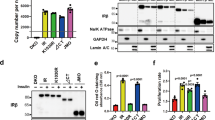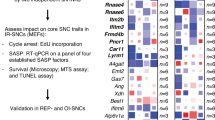Abstract
Fibroblastic cultures derived from normal human tissues undergo a finite number of population doublings when serially subcultivated in vitro (see refs 1, 2 for reviews). Epidermal growth factor (EGF) serves as a mitogen for early doubling level cultures of the human fetal lung-derived cell strain, WI-38, under serum-free conditions3. The ability of cells from late doubling level cultures to respond mitogenically to EGF is lost, however, despite undiminished binding of EGF throughout the replicative lifespan3. The ultimate effects of EGF, that is DNA synthesis and mitosis (see ref. 4 for review), occur after a sequence of events initiated by binding of ligand to specific cellular receptors5,6. The receptor for EGF has been characterized as a 145,000–165,000 (145 K–165 K) molecular weight doublet7,8, and, like the receptors for platelet-derived growth factor9 and insulin10,11, and the transforming proteins of certain of the RNA tumour viruses12–17, is a tyrosine-specific protein kinase with autophosphorylating activity8,18,19. Moreover, several of the cellular target molecules of tyrosine phosphorylation have been found to be substrates for two or more of these kinases20,21. The hypothesis that tyrosine phosphorylation underlies a common mechanism of growth control prompted us to ask whether the loss of responsiveness to EGF by late doubling level WI-38 cells is accompanied by altered expression of the EGF receptor, and specifically whether changes occur in the ability of receptors from populations of cells of various in vitro ages to catalyse tyrosine autophosphorylation. We show here that autophosphorylating activity is absent from the EGF receptor of cells which have lost their mitogenic responsiveness to EGF.
This is a preview of subscription content, access via your institution
Access options
Subscribe to this journal
Receive 51 print issues and online access
$199.00 per year
only $3.90 per issue
Buy this article
- Purchase on Springer Link
- Instant access to full article PDF
Prices may be subject to local taxes which are calculated during checkout
Similar content being viewed by others
References
Hayflick, L. Mech. Ageing Dev. 14, 59–79 (1980).
Cristofalo, V. J. & Stanulis-Praeger, B. M. in Advances in Cell Culture Vol. 2 (ed. Maramorosch, K.) 1–68 (Academic, New York, 1982).
Phillips, P. D., Kuhnle, E. & Cristofalo, V. J. J. Cell Physiol. 114, 311–316 (1983).
Carpenter, G. & Cohen, S. in Biochemical Actions of Hormones Vol. 5 (ed. Litwack, G.) 203–247 (New York, Academic, 1978).
Carpenter, G. & Cohen, S. J. Cell Biol. 71, 159–171 (1976).
Das, M. et al. Proc. natn. Acad. Sci. U.S.A. 74, 2790–2794 (1977).
King, L. E., Carpenter, G. & Cohen, S. Biochemistry 19, 1524–1528 (1980).
Carlin, C. R. & Knowles, B. B. Proc. natn. Acad. Sci. U.S.A. 79, 5026–5030 (1982).
Ek, B., Westermark, B., Wasteson, A. & Heldin, C.-H. Nature 295, 419–420 (1982).
Petruzzelli, L. M. et al. Proc. natn. Acad. Sci. U.S.A. 79, 6792–6796 (1982).
Roth, R. A. & Cassell, D. J. Science 219, 299–301 (1983).
Hunter, T. & Sefton, B. M. Proc. natn. Acad. Sci. U.S.A. 77, 1311–1315 (1980).
Collett, M. S., Purchio, A. F. & Erikson, R. L. Nature 285, 167–169 (1980).
Sefton, B. M., Hunter, T. & Raschke, W. C. Proc. natn. Acad. Sci. U.S.A. 78, 1552–1556 (1981).
Witte, O. N., Dasgupta, A. & Baltimore, D. Nature 271, 375–377 (1980).
Pawson, T. et al. Cell 22, 767–775 (1980).
Cooper, J. A. & Hunter, T. J. molec. cell. Biol. 1, 165–178 (1981).
Carpenter, G., Lembach, K. J., Morrison, M. & Cohen, S. J. biol. Chem. 250, 4297–4305 (1978).
Ushiro, H. & Cohen, S. J. biol. Chem. 255, 8363–8365 (1980).
Erikson, E., Shealy, D. J. & Erikson, R. L. J. biol. Chem. 256, 11381–11384 (1981).
Cooper, J. A., Bowen-Pope, D. F., Raines, E., Ross, R. & Hunter, T. Cell 31, 263–273 (1982).
Cristofalo, V. J. & Charpentier, R. J. Tissue Culture Meth. 6, 117–122 (1980).
Cristofalo, V. J. & Sharf, B. B. Expl. Cell Res. 76, 419–427 (1973).
Phillips, P. D. & Cristofalo, V. J. J. Tissue Culture Meth. 6, 123–126 (1980).
Phillips, P. D. & Cristofalo, V. J. Expl. Cell Res. 134, 297–302 (1981).
Hynes, R. O. Proc. natn. Acad. Sci. U.S.A. 70, 3170–3174 (1973).
Witte, O. N., Goff, S., Rosenberg, N. & Baltimore, D. Proc. natn. Acad. Sci. U.S.A. 77, 4993–4997 (1980).
Rosenberg, N., Clark, D. R. & Witte, O. N. J. Virol. 36, 766–774 (1980).
Snyder, M. A., Bishop, J. M., Colby, W. W. & Levinson, A. D. Cell 32, 891–901 (1983).
Schreiber, A. B., Libermann, T. A., Lax, L., Yarden, Y. & Schlessinger, J. J. biol. Chem. 258, 846–853 (1983).
Cassel, D., Pike, L. J., Grant, G. A., Krebs, E. G. & Glaser, L. J. biol. Chem. 258, 2945–2950 (1983).
Gross, J. L., Krupp, M. N., Rifkin, D. B. & Lane, M. D. Proc. natn. Acad. Sci. U.S.A. 80, 2276–2280 (1983).
Cohen, S., Ushiro, H., Stoscheck, C. & Chinkers, M. J. biol. Chem. 257, 1523–1531 (1982).
McKeehan, W. L., McKeehan, K. A., Hammond, S. L. & Ham, R. G. In Vitro 13, 399–416 (1977).
Scatchard, G. Ann. N. Y. Acad. Sci. 51, 660–672 (1949).
Croce, C. M. & Koprowski, H. J. exp. Med. 140, 1221–1229 (1974).
Aden, D. P. & Knowles, B. B. Immunogenetics 3, 209–221 (1976).
Knowles, B. B. et al. J. exp. Med. 145, 314–326 (1977).
Goldstein, L. T., Klinman, N. R. & Manson, L. A. J. natn. Cancer Inst. 51, 1713–1715, (1973).
Fabricant, R. N., DeLarco, J. E. & Todaro, G. J. Proc. natn. Acad. Sci. U.S.A. 74, 565–569, (1977).
Ford, S. R., Aden, D. P., Mausner, R., Trinchieri, G. & Knowles, B. B. Immunogenetics, 6, 293–300 (1978).
Cullen, S. E. & Schwartz, B. D. J. Immun. 117, 136–142 (1976).
Beemon, K. & Hunter, T. J. Virol. 28, 551–566 (1978).
O'Tarrell, P. H. J. biol. Chem. 250, 4007–4021 (1975).
Author information
Authors and Affiliations
Rights and permissions
About this article
Cite this article
Carlin, C., Phillips, P., Knowles, B. et al. Diminished in vitro tyrosine kinase activity of the EGF receptor of senescent human fibroblasts. Nature 306, 617–620 (1983). https://doi.org/10.1038/306617a0
Received:
Accepted:
Issue Date:
DOI: https://doi.org/10.1038/306617a0
This article is cited by
-
Survive or thrive: tradeoff strategy for cellular senescence
Experimental & Molecular Medicine (2017)
-
Occurrence of epidermal growth factor receptors in benign and malignant ovarian tumors and normal ovarian tissues: an immunohistochemical study
Journal of Cancer Research and Clinical Oncology (1992)
-
Characterization of MBT-2 tumour cell ?variant? resistant to tumour necrosis factor
Urological Research (1991)
-
Stimulation by transforming growth factor-β of epidermal growth factor-dependent growth of aged human fibroblasts: Recovery of high affinity EGF receptors and growth stimulation by EGF
In Vitro Cellular & Developmental Biology (1989)
Comments
By submitting a comment you agree to abide by our Terms and Community Guidelines. If you find something abusive or that does not comply with our terms or guidelines please flag it as inappropriate.



